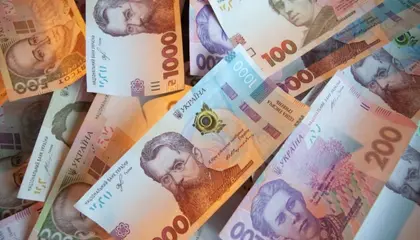On Feb. 21, the Ministry of Finance raised UAH9.6bn (US$261m) for the budget, mostly in local currency, rejecting part of the demand for all offered hryvnia bonds.
The shortest paper was oversubscribed for the first time in four weeks. With a cap of UAH500m (US$13.6m), demand amounted to UAH641m (US$17.5m), mainly in non-competitive bids. Competitive demand was unanimous at a rate of 15%, so most likely, all competitive bids were satisfied, and non-competitive demand was satisfied within the rest of the cap.
JOIN US ON TELEGRAM
Follow our coverage of the war on the @Kyivpost_official.
Twelve-month bills did not receive much demand, just UAH151m (US$4.1m), but the bid for UAH100m (US$3.7m) required a rate increase to 25%, so it was rejected.
"Reserve" bonds usually receive significantly greater demand than the cap, more than five times. Therefore, the MoF sold 30% of the offering under non-competitive bids, and 70% of the cap to those who submitted the lowest interest rates in their competitive bids. As a result, the cut-off rate for this paper was set at 18.6%, and the weighted average rate at 18.51%, which is 65bp and 56bp lower than last week.
While the increase in demand for seven-month OVDPs was mainly unexpected, the demand for "reserve" paper and another reduction in rates were expected. Currently, according to the auction schedule, the MoF will offer new "reserve" paper in two weeks, so banks rushed to buy bonds to cover part of the required reserves now. Therefore, competition for the opportunity to purchase them immediately, and not in two weeks, was high.

New Year: Changes for Economy, Business and Citizens
Bonds: Portfolios of UAH bonds shrinking
Last week, a significant amount of local-currency bonds were redeemed, which led to reduction in portfolios of most groups of investors.
Last Wednesday, the Ministry of Finance paid off UAH12.1bn of UAH bonds, but sold new bills with a face value of only UAH7.2bn (see details in the auction review). Therefore, total outstanding UAH bonds declined by UAH4.9bn. Only banks and municipalities increased their portfolios by UAH1.0bn and UAH0.2bn, respectively. Meanwhile, non-banking institutions, individuals, and foreign investors reduced their portfolios significantly by UAH2.0bn, UAH1.0bn, and UAH3.1bn, respectively.
By the end of the week, non-banking institutions and individuals resumed purchases and increased their holdings by a net UAH0.1bn and UAH0.5bn, respectively, over the week. However, foreigners continued to reduce investments in UAH bonds by UAH3.7bn last week.
On the secondary market, trading amounted to UAH3bn last week, including the most actively traded securities maturing in February 2025 for UAH1.2bn, in May 2026 for UAH0.5bn and "reserve" paper maturing in December 2024 in the amount of UAH0.4bn, or 40%, 18% and 14% of the total trading volume, respectively.
ICU view: Most likely, banks purchased the majority or even the entire volume of bonds that are allowed to be used to meet reserve requirements. Banks, thus, slightly increased their portfolios of UAH government bonds. At the same time, non-banking institutions and individuals prefer purchases on the secondary market where paper offers higher yields than in the primary segment. However, foreigners keep selling bonds, especially those maturing in February 2025. Foreign investors are probably waiting for additional confirmation that the NBU will not push back the time window for repatriation of their investments into government debt.
Bonds: Eurobonds continue to lose in price
Ukrainian Eurobonds continued to fall in price last week as they were influenced mostly by Ukrainian news and risks.
Over the past week, Eurobonds continued to lose in price after a significant price correction on the Friday a week before. In total, during these eight days, prices lost 7–9% or up to two cents, except for the shortest two issues that lost about 3% or less than one cent. Eurobonds were priced at 18–24% of the face value last Friday.
The VRI remained steady last week at about 28 cents on the dollar of notional face value, having lost almost 12%, or about 4 cents since the previous Thursday.
ICU view: Ukrainian Eurobonds continued to be mainly affected by local news rather than global sentiment. Moody's decision to downgrade Ukraine's sovereign rating was yet another negative factor against the backdrop of world media reports about intensified battles on the frontline.
FX: Cash hryvnia appreciates again
The hryvnia exchange rate continued to strengthen last week on the cash market; buy-sell spreads also continued to narrow.
Over the past week, cash hryvnia strengthened by more than 0.5% or UAH0.21 from UAH39.43–40.16/US$ to UAH39.22–39.95/US$ in the leading retail banks. Since the beginning of the year, cash hryvnia has strengthened by almost 2%. The spread between buy and sell rates narrowed to UAH0.73 from UAH0.95 at the beginning of January 2023.
ICU view: Last week, leading retail banks once more reset the cash exchange rate to lower levels for retail customers, which underscores the situation in the cash market, which remains broadly stable. According to the NBU, bank clients continue to buy more hard currency than they sell, but this does not affect the overall situation since banks have enough cash to meet demand. Large amounts of US dollars and euros may come from individuals' deposits for which they purchased hard currency at favorable rates.
RESEARCH TEAM: Vitaliy Vavryshchuk, Alexander Martynenko, Taras Kotovych
See full report here.
You can also highlight the text and press Ctrl + Enter






